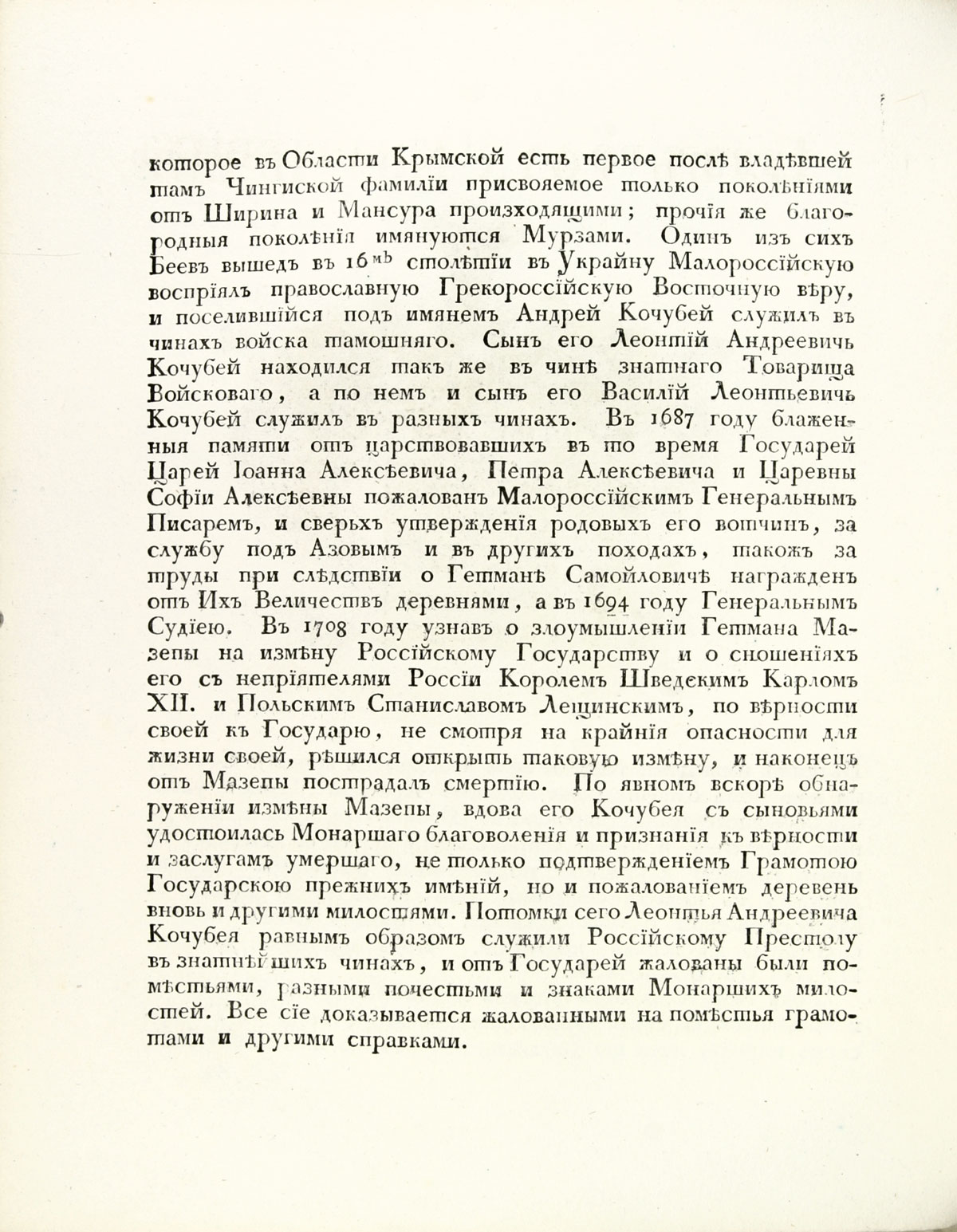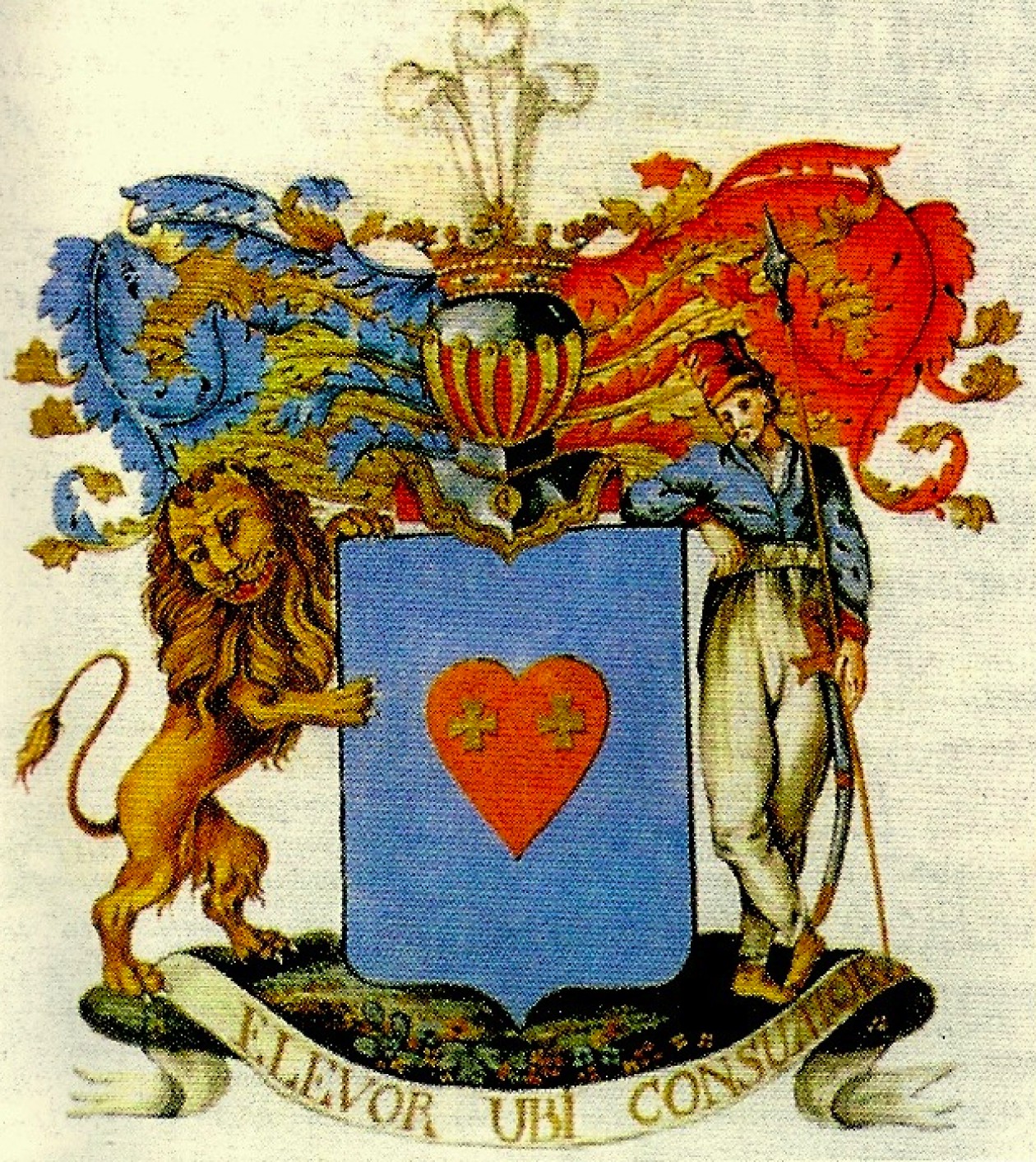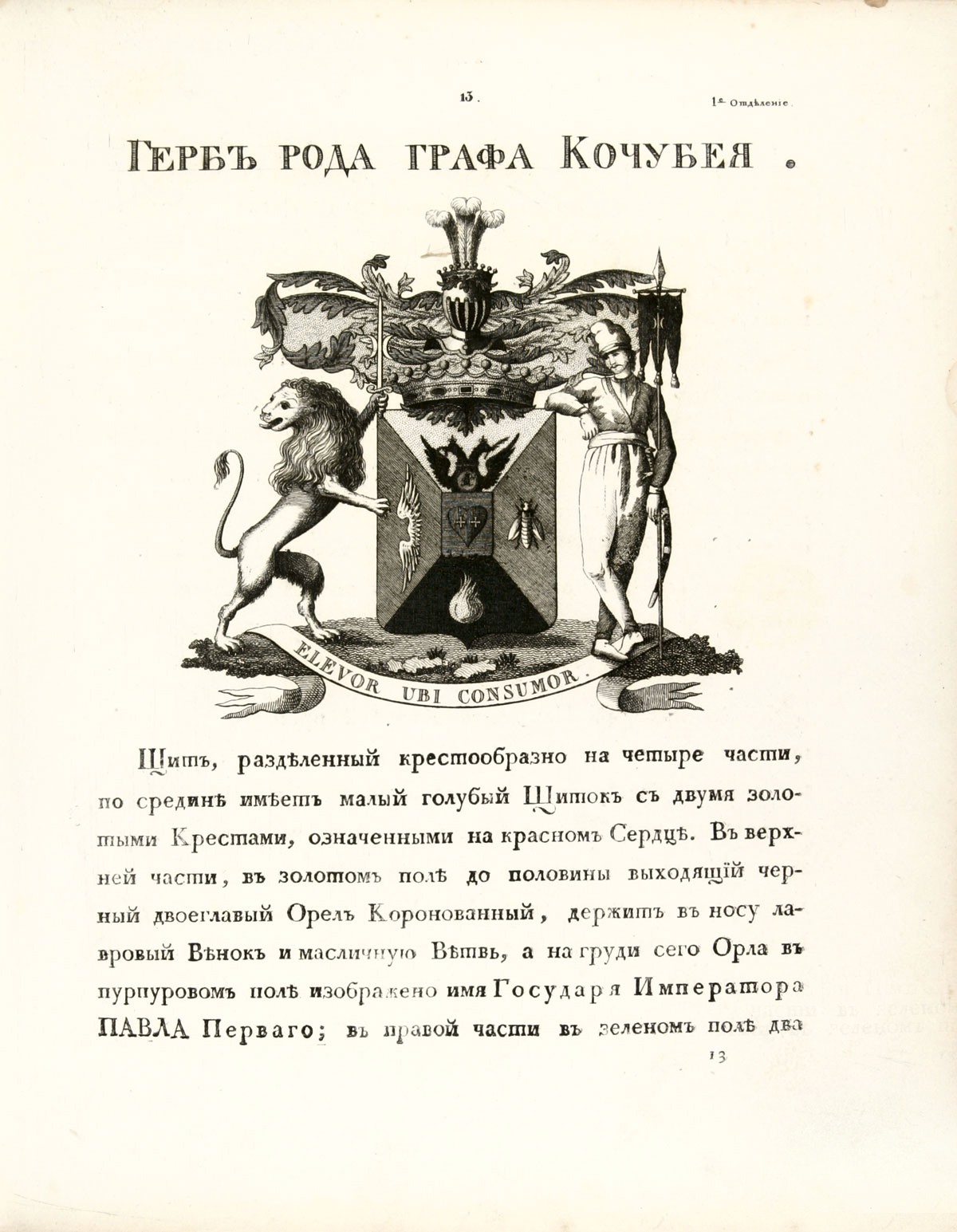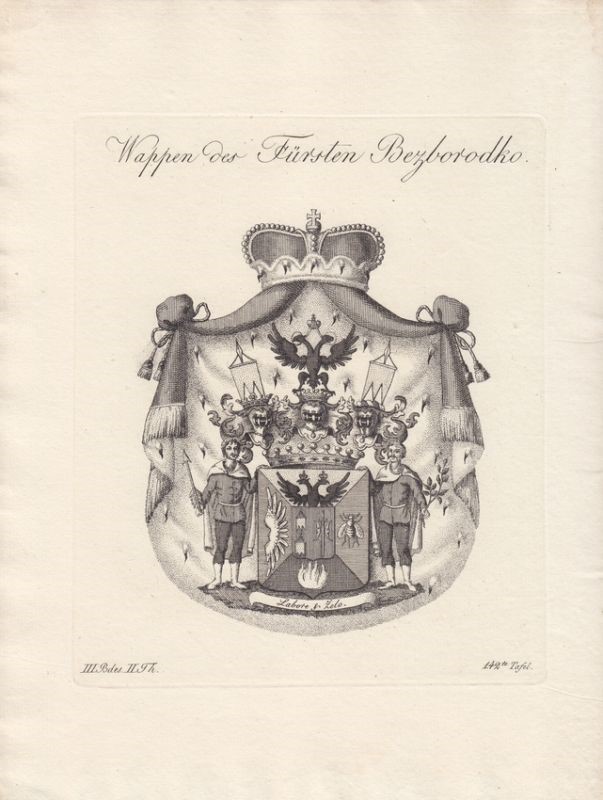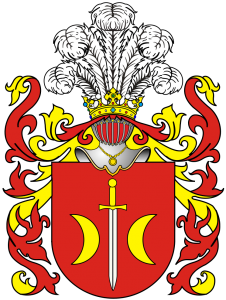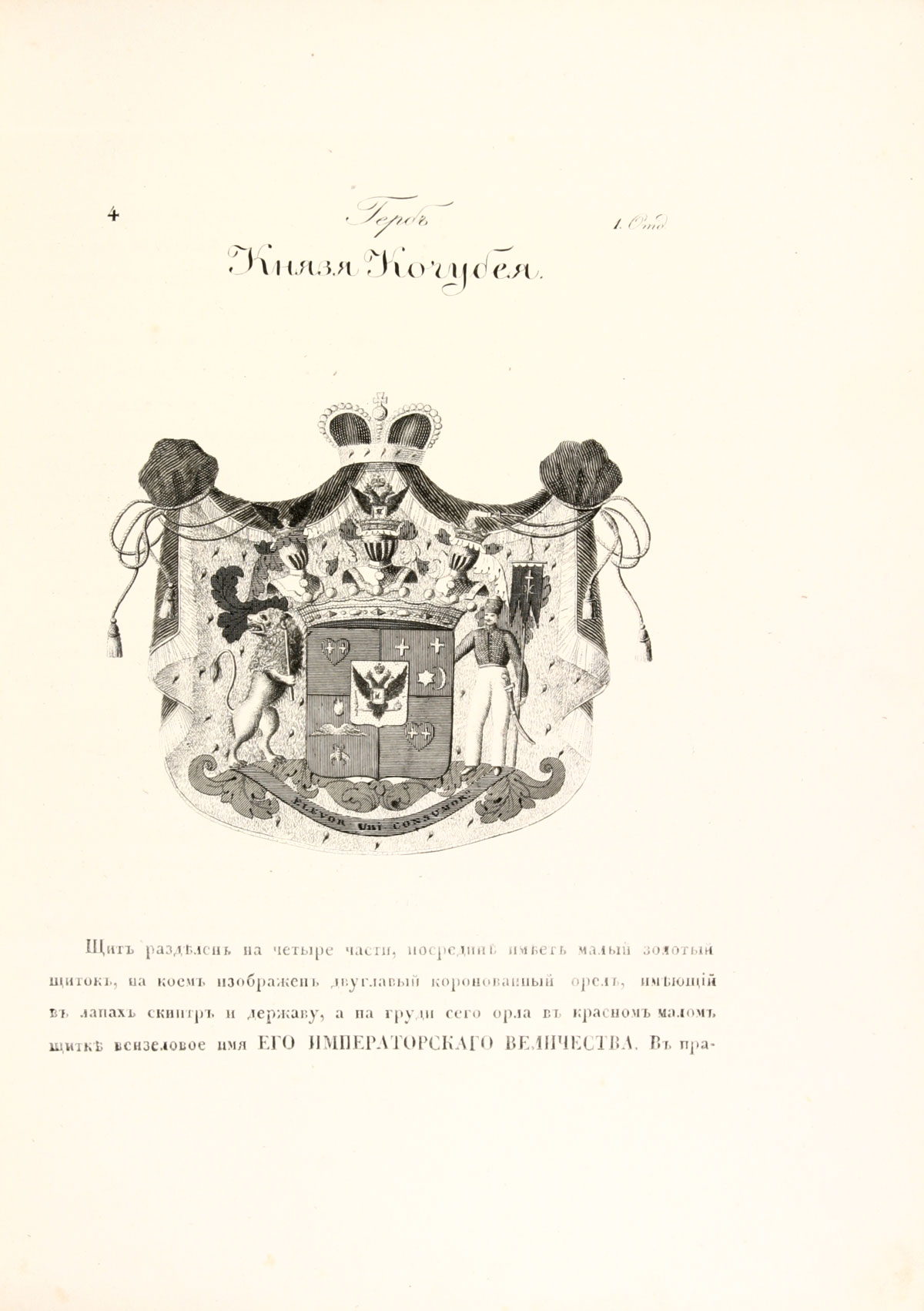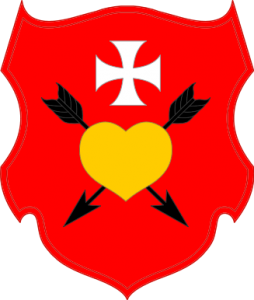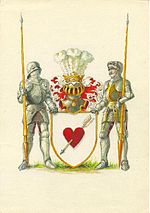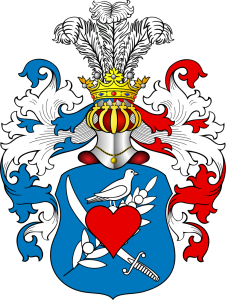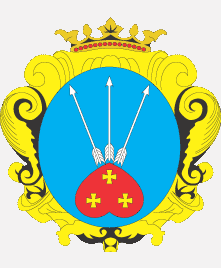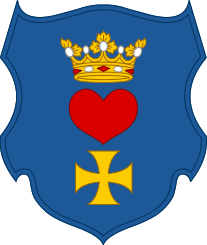The Kotchoubey coat of arms
…in its Russian Imperial form consists of a red heart set with two golden crosses which are in the form of a cross pattée or the St. George’s cross. The heart, of course, symbolises loyalty and the crosses are symbols of faith and both are common enough motifs in the Poltava province. This would suggest that the primary use of the heart in the Kotchoubey coat of arms is linked to the family’s origins and Poltava in the 17th century. Further, the heart sits in a field of azure or sky blue. On the left side is a lion and the right side a cossack or Ukrainian (Malorussia) warrior which is a device taken directly from the coat of arms of the Zaporizhian Sich state and used today in the state emblem of Ukraine.
The coat of arms above is described in Russian in the two pages at the start of this article which then goes on to summarise the origins of the Kotchoubey family. It is a summary to be taken with a a degree of skepticism as it was an exercise in self serving propaganda as are all family histories in the context of their past. The coat of arms in question was awarded by the Russian Imperial College of Heraldry in the mid Petrine era in the years after the execution of Vassili Leontevitch Kotchoubey in 1708. The family’s motto, “Elevor Ubi Consumer” is a reference to the execution of Vassili Leontivitch and means “I rise when destroyed.” The family’s origins had already been written and researched by Vassili Leontievitch as he had received the Gramota which officially recognised the nobility of the Kotchoubey family.
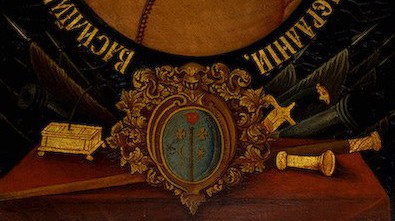
A likely posthumous portrait (found on the front page of this website) of Vassili Leontievitch carries a coat of arms that may have been used by him in the late 17th century most likely after the award of the original Russian Imperial Gramota. It carries the heart with two gold crosses as well as two gold crosses a top a half moon and star. Between them a pernatch which was the symbol of power of a Colonel of the Zaporozhian Sech.
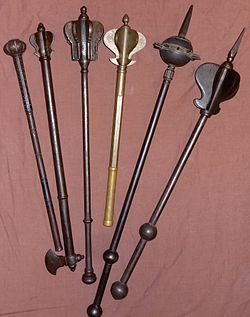 Missing on the actual portrait is Vassili Leontievitch with a Judge General’s baton or staff which was the traditional symbol of justice and it accompanied portraits of many Zaporzhian Judge Generals.
Missing on the actual portrait is Vassili Leontievitch with a Judge General’s baton or staff which was the traditional symbol of justice and it accompanied portraits of many Zaporzhian Judge Generals.
One explanation suggests that the image of the crosses on top of the half moon and star symbolises the victory of Christianity over Islam. After all, Kutchuk Bey abandoned his muslim faith and was christened and took the name Andrei in the mid 17th century. Alas, the crosses and the half moon and star are traditional symbols of many Polish-Lithuanian and Ukrainian family coat of arms as well as those of numerous villages and cities. In fact, on the floors of the Saint Sophia Cathedral in Kiev, visitors can look at the metal work floor which incorporates a design of four moons and four stars.
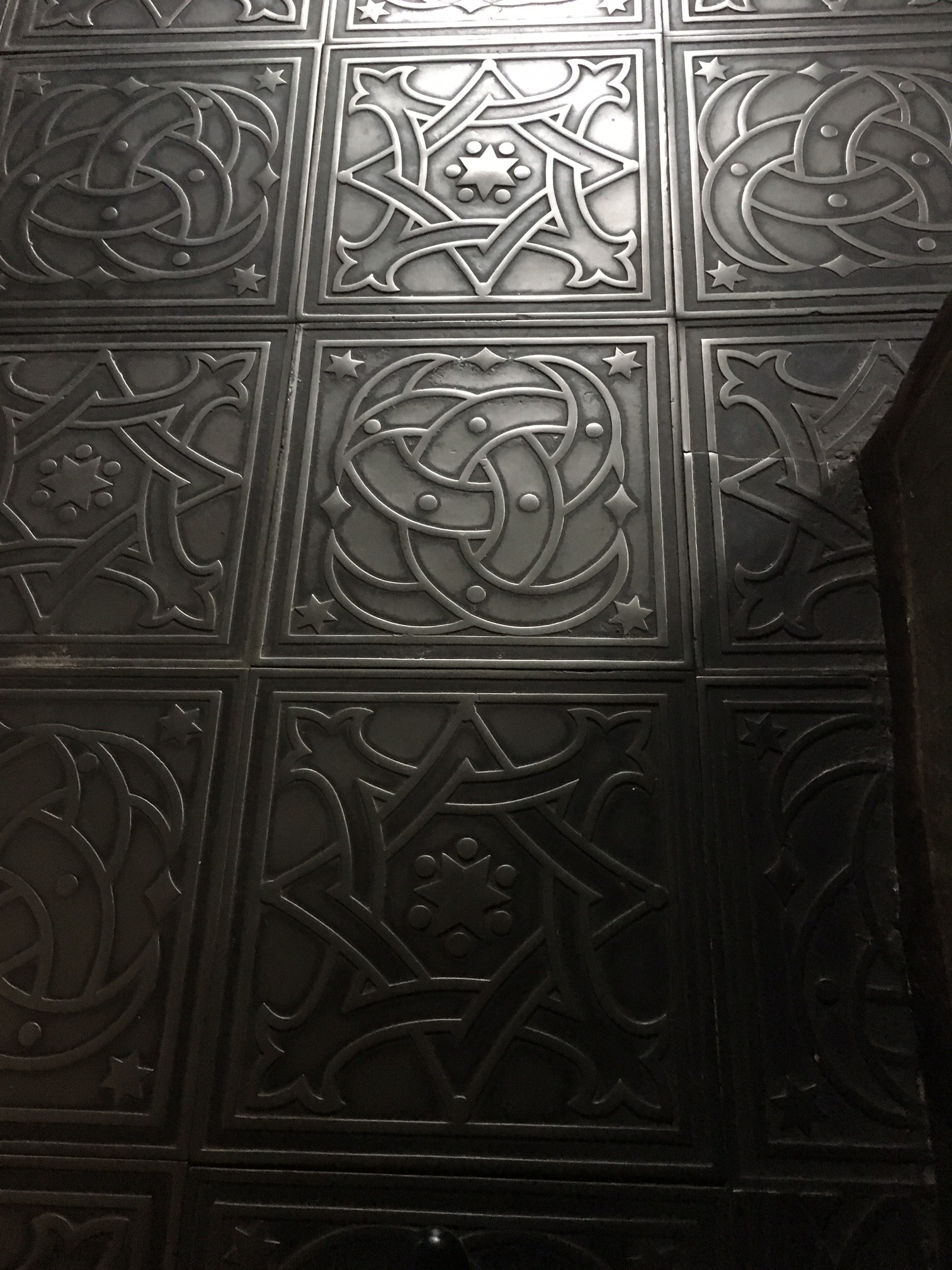
Metropolitan Piotr Mohyla / Петро Симеонович Могила (1596-1647) who came from a Moldovan boyar family and was a renowned theologian and Metropolitan of Kiev, had many of the familiar heraldric devices on his coat of arms including the half moon and star as well as the bull’s head which would also be found on the Sturdza family crest.
While the two crosses above the half moon and star were not used in the official Russian Imperial Coat of Arms of the Kotchoubey family, but they were introduced back into the Coat of Arms in 1834 when Count Victor Pavlovitch was awarded a princely title by Emperor Nicholas I. Interestingly enough the style of the crosses changes and they become simple crosses which suggests that these are stylistic choices and are not meant to reflect any meaning.
Kotchoubey Counts & Prince
Victor Pavlovitch Kotchoubey was made a count of the Russian Empire by Paul I in 1799 thus conferring the title on Victor Pavlovitch and his wife Countess then Princess Maria Vassilievna Kotchoubey (née Princess Vassiltchikov) / Княгиня Мария Васильевна Кочубей (урождённая княжна Васильчикова) (1779-1844) and their children. A year before his death, Victor Pavlovitch was made a Prince in 1834 and thus the princely title was carried by his immediate family and all their descendants. the last of the Kotchoubey Princes passed away in the 1950s.
Bezborodko Coat of Arms (as counts and Princes)
 The coat of arms adopted by Count Victor Pavlovitch was taken directly from his mother Juliana Andreevna Kotchoubey (née Bezborodko / Ульяна Андреевна Кочубей (урожд. Безбородко) (1742—1777) and the Kotchoubey coat of arms was imposed on the central shield. The decision to adopt the Bezborodko coat of arms was not only fitting as a tribute to his maternal line but it was probably in large part a recognition of the fact that his uncle H.S.H Prince Alexander Andreevitch Bezborodko / светлейший князь Александр Андреевич Безбородко (1747-1799) raised him from childhood and launched his diplomatic and government career. The superimposed Kotchoubey coat of arms dislodged the banners and the sword with the half moon motifs which appear on the Bezborodko coat of arms and these elements were then moved to the Cossack figure on the right side of the main shield and the sword with two moons is then held aloft by the lion on the left. The heraldic devices of the sword and two half moons that is denoted on the Bezborodko shield may come from either the Przegonia clan or the Ostroja clan in Poland but it is not clear how it is connected to the Bezborodko’s.
The coat of arms adopted by Count Victor Pavlovitch was taken directly from his mother Juliana Andreevna Kotchoubey (née Bezborodko / Ульяна Андреевна Кочубей (урожд. Безбородко) (1742—1777) and the Kotchoubey coat of arms was imposed on the central shield. The decision to adopt the Bezborodko coat of arms was not only fitting as a tribute to his maternal line but it was probably in large part a recognition of the fact that his uncle H.S.H Prince Alexander Andreevitch Bezborodko / светлейший князь Александр Андреевич Безбородко (1747-1799) raised him from childhood and launched his diplomatic and government career. The superimposed Kotchoubey coat of arms dislodged the banners and the sword with the half moon motifs which appear on the Bezborodko coat of arms and these elements were then moved to the Cossack figure on the right side of the main shield and the sword with two moons is then held aloft by the lion on the left. The heraldic devices of the sword and two half moons that is denoted on the Bezborodko shield may come from either the Przegonia clan or the Ostroja clan in Poland but it is not clear how it is connected to the Bezborodko’s.
Ostroja Coat of Arms (modern version)
The origins of the family coat of arms (i.e the red heart and two crosses) are not entirely clear but they must certainly borrow from regimental, city and family coats of arms in the region. For example, Ivan Mazeppa‘s coat of arms carries a half moon and star as does the coat of arms of Baturyn, the capital of the Hetmanate state and it is likely that the Kotchoubey coat of arms borrows heavily from the city’s coat of arms.
On a tour with Natalia Rebrova, the director of the Baturyn Museum complex in Ukraine, she pointed to a number of recurring half moon and stars in use in various decorative forms. This was especially the case with the imagined interiors of the English Architect, Cameron’s palace that he designed for the last Hetman Kyrylo Razumovsky in Baturyn and which was recently restored by the Ukrainian state. While there is no evidence that these elements were original to the interior, she explained to me that these elements are a common motif in Ukrainian heraldry and decoration and they represent the desire to obtain the heavans.
City of Baturyn (Tchernigov Province) from 1671
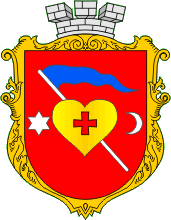
Baturyn was not the only city to carry the heraldic device of a moon and a cross. Further up norther in the Kaluga region outside of Moscow, the ancient city of Borovsk was also awarded a heraldic shield in 1771 which carried the now familiar red heart and gold cross surrounded by a wreath. The date of this shield suggests it was awarded a hundred years after it was already in use by the Kotchoubey family and there are no known links between the family and the city. Again, the symbolic role of the heart for loyalty and the cross for faith become the central guiding elements for the city’s coat of arms.
City of Borovsk (Kaluga Province) from 1771

City of Glinsk (Poltava Province, Imperial Russia) 1782
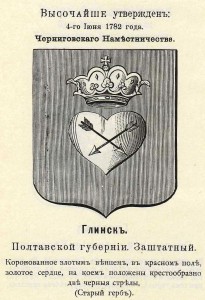 Already in modern day Ukraine, the appearance of the heart and the cross become more common in city and regional heraldry for example, in the Sumy Province where the Kotchoubeys lived for hundreds of years especially with the appointment of the city of Glukhov as the new capital of the Cossack State after the destruction of Baturyn in 1709 by the Russian army under the command of Prince Alexander Menschikoff. These include the village of Kuzmin and Dikanka as well as
Already in modern day Ukraine, the appearance of the heart and the cross become more common in city and regional heraldry for example, in the Sumy Province where the Kotchoubeys lived for hundreds of years especially with the appointment of the city of Glukhov as the new capital of the Cossack State after the destruction of Baturyn in 1709 by the Russian army under the command of Prince Alexander Menschikoff. These include the village of Kuzmin and Dikanka as well as
Village of Kuzmin (Sumy Province, Ukraine)
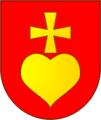
the little village of Dubovichi, the latter two being among the ancestral villages of the Kotchoubey family. Dikanka was of course one of the first of the Kotchoubey estates and remnants of the family’s building endeavors remain including two churches and a formal triumphant arch which is featured on the village coat of arms. Dubovitchi was home to a now missing Miraculous Icon, two churches of which one was the family’s church where generations of the family were laid to rest in the crypt. Today, the ravages of the 20th century have destroyed both churches in this village and nothing remains but memorial plaques and a sunken indentation in the ground suggesting that a structure once stood on land that is now being over grown with trees.
Village of Dikanka / Диканька (Poltava Province, Ukraine)
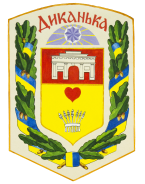
Village of Dubovichi (Sumy Province, Ukraine)

Finally and most importantly, the Province of Poltava in Ukraine has integrated elements of the Kotchoubey family Coat of Arms. On a provincial level the new the coat of arms has elements of the Tsarist pre-revolutionry heraldic device for Poltava of the stars and the bow & arrow, while in the corners have been added the golden cross pattée on a blue field used primarily by the Hetman Polubotok. In another corner is the red heart, a now recognisable device which has come to represent the family.
Province of Poltava (Ukraine)
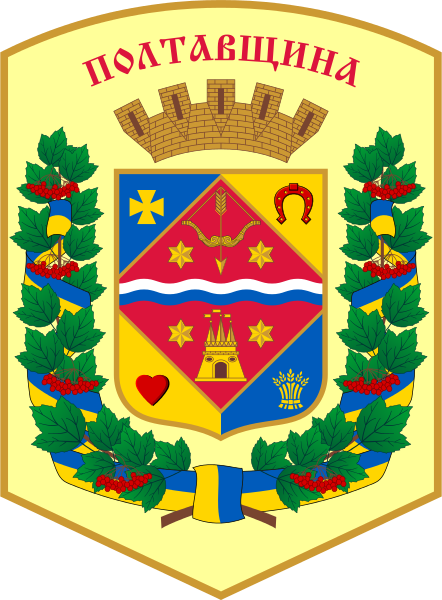
The coat of arms of the region of Poltava uses the familiar motif of the heart, too but where as the red heart is a Kotchoubey symbol, the golden heart with two piercing crossed arrows, and a cross pattée is the coat of arms of Hetman Pavlo Polubotok. It is in fact, the elements of the Polubotok family which are most evident in the Poltava region’s arms.
Coat of Arms of Poltava Region (Poltava Province, Ukraine)
 Coat of Arms of Hetman Pavlo Polubotok (1660-1724)
Coat of Arms of Hetman Pavlo Polubotok (1660-1724)
While the use of the heart is found in a number of Tsarist city coat of arms, it is also prevalent in a number of family coat of arms and these include two families that produced Hetmans; the Polubotok family and the Loboda family. In addition, one other Malorussian/Ukrainan family has a red heart in the coat of arms and they are the Markevich family. The Markevitch’s married into the Kotchoubey family in the 19th century and several family members were laid to rest in the Kotchoubey family crypt in Dubovichi, located in the Sumy Province of modern day Ukraine. Another noble Malorussian family with military origins in Korsun in the 17th century are the Kostenetskiy / Костенецкий who also have a coat of arms that resembles that of the Kotchoubeys. Needless to saym members of both families intermarried among the local landed nobility in the 18th & 19th centuries. Towards the end of the 17th century, the family move to the Chernigov region and settle near Konotop where among their illustrious members is a hero of the war of 1812, General Vassily Gregorovitch Kostenetskiy / Василий Григорьевич Костенецкий (1766—1831). It is perhaps then not a surprise that the regional ties produce a coat of arms (see below) which is an azure blue field with an upside down red heart with three golden knight’s crosses upon it and three silver arrows eminating upwards. Finally, the Aksakov family which descended from a Scandanavian prince who settled in Novgorod in the 11th century also had a red heart in their family’s coat of arms. By the 19th century, the family had settled in Ufa.
Coat of Arms of the Aksakov Family (Novgorod-Ufa)
Coat of Arms of Hetman Gregory Loboda (-1596)
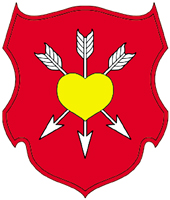
Coat of Arms of the Markevitch/Markovitch family
Coat of Arms of the Kostenitskiy (Костенецкие) family
Another coat of arms with a similar motif is that of the Perekrestov-Ossipov (Перекрестов-Осипов), a noble family whose origins go back the the second half of the 17th century and stem from military origins. The founder of the family was Ivan Ivanovitch Perekrestov, a colonel in the Akhtyrsky Sloboda Cossack regiment ( Ахтырский слободской казачий полк) near present day Kharkhiv. Their lands and the family settled around Kharkhiv, Poltava, Tchernigov and Kursk. Unlike the Kotchoubey heart, the Perekrestov-Ossipov heart is golden on a sky blue background.
Coat of Arms of the Perekrestov-Ossipov (Перекрестов-Осипов) family
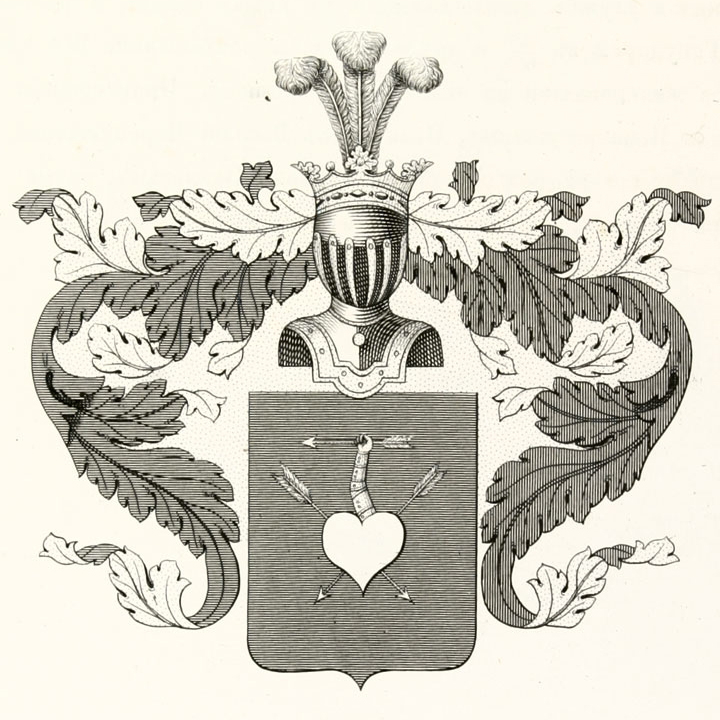 The final clue, however far fetched it is, can be found in the regimental arms of two cossack regiments that existed briefly in the 17th century. While the Irkliyiv regiment was created in 1648 and then folded into the Kropyvna regiment which itself was later split into two regiments in 1658, they both carry elements of the Kotchoubey red heart and in the case of the Kropyvna regiments the cross and a nobleman’s crown. However, the regimental arms may have been a more recent invention that stems from the 1771 arms of the city of Kropyvna, the regimental administrative center. Based on these regimental banners, could it be that the Kotchoubey heart was borrowed from the Kropyvna regiment /Кропивнянський полк which was somehow tied to Leonti Andreivitch Kotchoubey of whom little is known other than that he was a Buchukowski comrade of Hetamn Bogdan Khemlitski? It is just a wild conjecture for now.
The final clue, however far fetched it is, can be found in the regimental arms of two cossack regiments that existed briefly in the 17th century. While the Irkliyiv regiment was created in 1648 and then folded into the Kropyvna regiment which itself was later split into two regiments in 1658, they both carry elements of the Kotchoubey red heart and in the case of the Kropyvna regiments the cross and a nobleman’s crown. However, the regimental arms may have been a more recent invention that stems from the 1771 arms of the city of Kropyvna, the regimental administrative center. Based on these regimental banners, could it be that the Kotchoubey heart was borrowed from the Kropyvna regiment /Кропивнянський полк which was somehow tied to Leonti Andreivitch Kotchoubey of whom little is known other than that he was a Buchukowski comrade of Hetamn Bogdan Khemlitski? It is just a wild conjecture for now.
Irkliyiv Regiment (1648) merged with the Kropyvna


